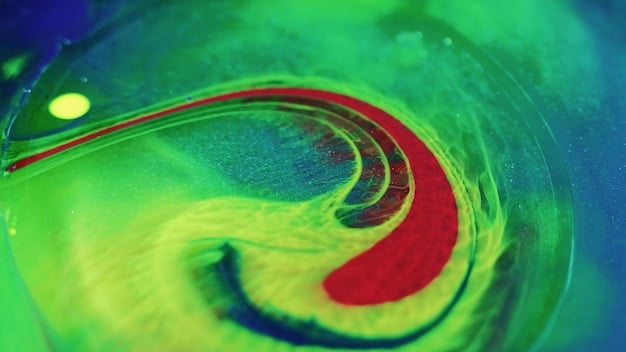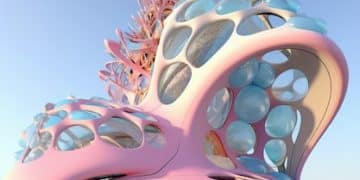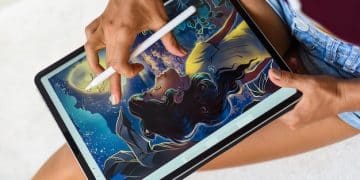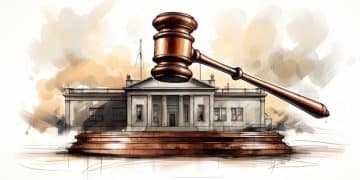AI’s Creative Revolution: Exploring Impacts on Art & Culture

The impact of artificial intelligence on creative expression and cultural production is reshaping artistic landscapes, offering new tools and challenging established norms in art, music, literature, and beyond, impacting how culture is created and consumed.
The rise of artificial intelligence is no longer a futuristic fantasy; it’s a present-day reality profoundly affecting various aspects of our lives, including creativity and culture. Understanding the impact of artificial intelligence on creative expression and cultural production requires examining its influence within artistic fields and its potential to redefine how we perceive art itself.
AI as a Creative Partner: Transforming Artistic Processes
Artificial intelligence is increasingly being viewed as more than just a tool. It’s evolving into a collaborative partner, assisting artists and creators in exploring new boundaries and pushing the limits of traditional creativity. This partnership is transforming how art is conceived, developed, and experienced.
AI-Assisted Music Composition
AI algorithms are now capable of generating original musical pieces, composing melodies, and even harmonizing complex arrangements. These tools allow musicians to explore new sonic landscapes and develop unique compositions, expanding the possibilities for musical creation.
AI’s Influence on Visual Arts
From generating photorealistic images to creating abstract digital art, AI is making waves in the visual arts. Artists are using AI to produce stunning visuals, manipulate images, and explore entirely new artistic forms, challenging conventional notions of artistic skill and originality.
- Exploring new aesthetic styles and visual languages.
- Automating repetitive tasks, freeing up artists’ time for creative strategy.
- Personalizing artistic experiences for audiences through interactive AI installations.

In this symbiotic relationship, AI not only augments human creativity but also raises fundamental questions about originality, authorship, and the very definition of art in the digital age. As AI continues to advance, its role as a creative partner will only become more prominent and influence more facets of creative expression.
The Democratization of Creativity: AI for Everyone
One of the more significant impacts of AI is the democratization of creative tools. Previously, sophisticated tools and skills were often required to engage in creative activities, but AI is changing that. Now, individuals can use AI-powered applications to express their visions without needing extensive training.
AI-Powered Design Platforms
AI-driven design platforms simplify the creative process, allowing users to generate logos, web layouts, and marketing materials effortlessly. These platforms put creative power in the hands of entrepreneurs, small businesses, and hobbyists alike.
AI’s Role in Content Creation
AI tools are increasingly used to generate content, from writing articles to producing videos. These AI-driven applications democratize content creation, enabling anyone to produce professional-quality material with ease, even without traditional skills.
- Lowering entry barriers for creative endeavors.
- Encouraging broader participation in the arts and culture.
- Promoting diversity in creative content and viewpoints.
The democratization of creativity has profound implications for culture. It allows a wider range of voices to be heard, leading to a more diverse and inclusive cultural landscape. This evolution promises a rich tapestry of perspectives previously unheard.
Challenges to Traditional Artistic Norms: Authorship and Authenticity
As AI gains prominence in creative fields, fundamental questions surrounding authorship, authenticity, and originality come to the forefront. These discussions are critical as we redefine the role of humans in the creative process and assess the value of AI-generated works.
Defining Authorship in AI Art
When AI creates a work of art, who is considered the author? Is it the programmer who designed the AI, the user who provided the input, or the AI itself? Exploring these questions is essential for copyright regulations and the valuation of AI-generated artistry.
The Authenticity Debate
The authenticity of art has always been a significant criterion for evaluation. When AI replicates artistic styles or generates works similar to human creations, questions arise about whether such art can be considered genuine or simply imitative.
- Reinterpreting the traditional understanding of creativity and originality.
- Developing new frameworks for copyright and intellectual ownership.
- Evaluating the emotional and sensory experience provided by AI-generated art.

Navigating these challenges requires open dialogues within the creative community, as well as thoughtful consideration from legal and ethical perspectives. The future of art may depend on our ability to address these complex issues thoughtfully.
AI’s Impact on Cultural Preservation and Heritage
Artificial intelligence is not only transforming creative industries but also providing innovative ways to preserve and promote cultural heritage. AI applications can digitize artifacts, restore damaged artworks, and create immersive cultural experiences, ensuring that our shared history endures for future generations.
Digitizing Cultural Artifacts
AI-driven image analysis and scanning techniques can rapidly digitize vast collections of historical documents, artworks, and archaeological finds, making them accessible to researchers and the public worldwide. This process helps safeguard these treasures against loss or damage.
Restoring Damaged Artworks
AI algorithms can analyze and reconstruct degraded or damaged artworks, helping conservators restore them to their original condition. This technology can fill in missing details, correct color fading, and even remove layers of grime without causing further harm.
- Enabling broader access to cultural resources through digital archives.
- Enhancing educational experiences through interactive simulations.
- Supporting sustainable tourism and cultural exchange initiatives.
By harnessing the power of AI, we can ensure that cultural heritage is not only preserved but also celebrated and shared across the globe. This approach enables a deeper understanding of our shared human story.
Ethical Implications and Future Concerns
While the integration of AI in creative expression holds immense potential, it also raises ethical concerns about bias, job displacement, and the commodification of art. Addressing these issues is vital for ensuring that AI serves as a force for good in the creative landscape.
Addressing Algorithmic Bias
AI algorithms are trained on data, and if that data reflects existing biases, the AI may perpetuate and amplify those biases in its creations. It is crucial to develop strategies for detecting and mitigating algorithmic bias to ensure equitable artistic outcomes.
The Impact of AI on Creative Professions
As AI becomes more capable of generating art, concerns arise about the potential displacement of human artists and creatives. Exploring ways to support artists and help them adapt to this changing landscape is essential for preserving artistic livelihoods.
- Developing ethical guidelines for the use of AI in cultural contexts.
- Promoting education and training to help artists leverage AI effectively.
- Creating policies that support artistic communities.
Thoughtful and conscientious planning is necessary to ensure that the benefits of AI are distributed fairly and that the creative sector remains vibrant and sustainable.
The Evolving Cultural Landscape: A Symbiotic Future
Looking ahead, the impact of artificial intelligence on creative expression and cultural production is set to become even more profound. As AI continues to evolve, its role in shaping our artistic and cultural experiences will deepen, leading to art forms we can only begin to imagine.
The Rise of Hybrid Art Forms
We can expect to see more art that seamlessly blends human and AI creativity, resulting in unique hybrid forms that transcend traditional boundaries. These collaborations will open up new avenues for artistic exploration and expression.
Personalized Cultural Experiences
AI will increasingly be used to tailor cultural experiences to individual preferences, creating highly personalized art, music, and entertainment. This personalized approach will enhance engagement and appreciation for the arts.
- Fostering creativity through diverse partnerships between humans and AI.
- Enhancing the accessibility and relevance of cultural works.
- Promoting continuous innovation and discovery in the arts.
The integration of AI into creative and cultural sectors offers the potential to enrich our lives, deepen our understanding of the world, and foster a more connected and creative society. Embracing AI’s possibilities, while mitigating its challenges, will be essential for shaping a vibrant cultural future.
| Key Point | Brief Description |
|---|---|
| 🎨 AI as Partner | AI collaborates in art, music, expanding creative boundaries. |
| 🌐 Democratization | AI tools enable broader participation in creative expression. |
| 🏛️ Heritage Preservation | AI aids in digitizing, restoring, and sharing cultural artifacts. |
| 🤔 Ethical Concerns | Bias in AI, job shifts, and art commodification pose challenges. |
Frequently Asked Questions
AI provides new tools for artists, democratizes creativity, and raises questions about authorship. It also helps preserve cultural heritage through digitization and restoration.
Debates persist about AI’s capacity for genuine creativity. However, AI’s ability to generate novel outputs and assist human artists is undeniable, expanding creative possibilities.
Ethical concerns include algorithmic bias, potential job displacement for artists, and questions surrounding copyright and ownership of AI-created works.
AI offers tools to digitize artifacts, restore damaged artworks, and create interactive cultural experiences. It also facilitates broader access to and appreciation of global cultural heritage.
AI is set to become even more integral, enhancing creativity via human-AI collaborations. Personalized cultural experiences and the rise of unique hybrid art forms are anticipated.
Conclusion
In summary, the influence of the impact of artificial intelligence on creative expression and cultural production is vast and transformative. While challenges such as ethical considerations and the need for adaptation within creative professions remain, the potential for enriched artistic landscapes and cultural accessibility is immense. The symbiotic relationship between humans and AI stands to redefine the future of creativity.





